Mating behaviour of Simulium erythrocephalum (De Geer, 1776) (Diptera: Simuliidae) in Zaragoza (Spain)
Abstract
Simulium erythrocephalum (De Geer, 1776) is a highly anthropophilic species that is responsible for blackfly outbreaks in Spain. Thus, field observations of the mating behaviour, including swarm formation, recognition and chasing, copulation, termination of copulation and post-copulation behaviour of S. erythrocephalum were conducted in a natural habitat in Spain. The obtained results demonstrated that mating activity occurs during the evening hours. We observed the human host represents an attractive orientation marker of male swarms, whose formation is related to the host-seeking activity period of females. This study represents the first report about the mating behaviour of Simuliidae species in Spain, increasing the general knowledge about this behaviour of blackflies.
Downloads
References
Adler P & Crosskey RW. 2018. World blackflies (Diptera: Simuliidae): a comprehensive revision of the taxonomic and geographical inventory [2018]. Available at: https://biomia.sites.clemson.edu/pdfs/blackflyinventory.pdf.
Adler PH, Currie DC & Wood DM. 2004. The black flies (Simuliidae) of North America. New York: Cornell University Press.
Crosskey RW. 1990. The Natural History of Blackflies. New York: John Wiley and Sons.
Davies DM & Peterson BV. 1956. Observations on the mating, feeding, ovarian development, and oviposition of adult black flies (Simuliidae, Diptera). Canadian Journal of Zoology 34: 615-655.
Downes JA. 1969. The swarming and mating flight of Diptera. Annual Review Entomology 14: 271-298.
Friederichs K. 1921. Untersuchungen über Simuliiden (Teil II). Bulletin of Entomological Research 8: 23-42.
Ignjatović-Ćupina A. 2011. Fauna simulida (Diptera: Simuliidae) pribrežja Fruške gore. (Black fly fauna (Diptera: Simuliidae) of the Fruška gora foothills). Univerzitet u Novom Sadu.
Jones JC & Pilitt DR. 1973. Observations on the sexual behavior of free-flying Aedes aegypti mosquitoes. Biological Bulletin 144: 480-488.
Peterson BV. 1959. Observations on mating, feeding, and oviposition of some Utah species of black flies (Diptera: Simuliidae) 1. Canadian Entomology 91: 147-155.
Rivosecchi L, Addonisio M & Maiolini B. I Ditteri Simulidi. 2007. Nuove chiavi dicotomiche per l` identificazione delle specie italiane con brevi note bio-tassonomiche. Trento: Quaderni del museo Tridentino di Scienze naturali, 2.
Ruiz–Arrondo I, Alarcón–Elbal PM, Figueras L, Delacour-Estrella S, Muñoz A, Kotter H, Pinal R & Lucientes J. 2014. Expansión de los Simúlidos (Diptera: Simuliidae) en España: Un nuevo reto para la Salud Pública y la Sanidad Animal. Boletín de la Sociedad Entomológica Aragonesa. 54:193-200.
Ruiz-Arrondo I, Garza-Hernández JA, Reyes-Villanueva F, Lucientes-Curdi J & Rodríguez-Pérez MA. 2017. Human-landing rate, gonotrophic cycle length, survivorship, and public health importance of Simulium erythrocephalum in Zaragoza, northeastern Spain. Parasites & Vectors 10: 175-184
Smart J. 1934. Notes on the Biology of Simulium pictipes Hagen. Canadian Entomologist 66: 62-66.
Wenk P. 1965. Ueber die Biologie blutsaugender Simuliiden. Zeitschrift für Morphologie und Ökologie der Tiere 55: 671-713.
Wenk P. 1987. Swarming and mating behavior of black flies. In Black Flies Ecology, Population Management and Annotated World List (Kim KC & Merrit W, eds.). Pennsylvania: Pennsylvania State University Press, pp. 215-227.
Wenk P & Raybould JN. 1972. Mating, blood feeding, and oviposition of Simulium damnosum Theobald in the laboratory. Bulletin of World Health Organization 47: 626-627.
Whittier TS, Kaneshiro KY & Prescott LD. 1992. Mating behavior of Mediterranean fruit flies (Diptera: Tephritidae) in a natural environment. Annals of the Entomological Society of America 85: 214-218.
Yuval B. 2006. Mating systems of blood-feeding flies. Annual Review Entomology 51: 413-440.

This work is licensed under a Creative Commons Attribution-NonCommercial-NoDerivatives 4.0 International License.
Las obras que se publican en esta revista están sujetas a los siguientes términos:
1. El Servicio de Publicaciones de la Universidad de Murcia (la editorial) conserva los derechos patrimoniales (copyright) de las obras publicadas, y favorece y permite la reutilización de las mismas bajo la licencia de uso indicada en el punto 2.
2. Las obras se publican en la edición electrónica de la revista bajo una licencia Creative Commons Reconocimiento-NoComercial-SinObraDerivada 3.0 España (texto legal). Se pueden copiar, usar, difundir, transmitir y exponer públicamente, siempre que: i) se cite la autoría y la fuente original de su publicación (revista, editorial y URL de la obra); ii) no se usen para fines comerciales; iii) se mencione la existencia y especificaciones de esta licencia de uso.
3. Condiciones de auto-archivo. Se permite y se anima a los autores a difundir electrónicamente las versiones pre-print (versión antes de ser evaluada) y/o post-print (versión evaluada y aceptada para su publicación) de sus obras antes de su publicación, ya que favorece su circulación y difusión más temprana y con ello un posible aumento en su citación y alcance entre la comunidad académica. Color RoMEO: verde.











